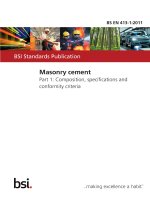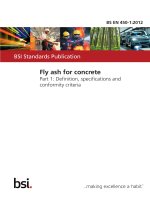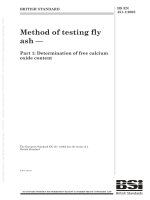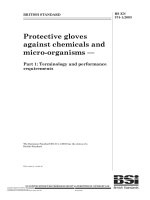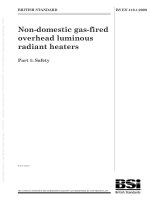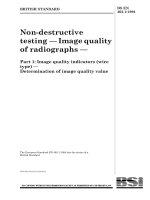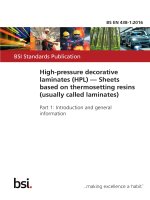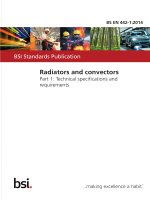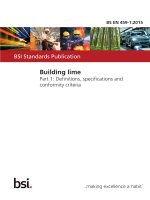Bsi bs en 10222 1 2017
Bạn đang xem bản rút gọn của tài liệu. Xem và tải ngay bản đầy đủ của tài liệu tại đây (1.02 MB, 28 trang )
BS EN 10222-1:2017
BSI Standards Publication
Steel forgings for pressure purposes
Part 1: General requirements for open die forgings
BS EN 10222-1:2017
BRITISH STANDARD
National foreword
This British Standard is the UK implementation of EN 10222-1:2017. It
supersedes BS EN 10222-1:1998, which is withdrawn.
The UK participation in its preparation was entrusted to Technical
Committee ISE/111, Steel Castings and Forgings.
A list of organizations represented on this committee can be obtained on
request to its secretary.
This publication does not purport to include all the necessary provisions
of a contract. Users are responsible for its correct application.
ISBN 978 0 580 80523 3
ICS 77.140.30; 77.140.85
Compliance with a British Standard cannot confer immunity from
legal obligations.
This British Standard was published under the authority of the
Standards Policy and Strategy Committee on 31 May 2017.
Amendments/corrigenda issued since publication
Date
Text affected
BS EN 10222-1:2017
EN 10222-1
EUROPEAN STANDARD
NORME EUROPÉENNE
EUROPÄISCHE NORM
April 2017
ICS 77.140.30; 77.140.85
Supersedes EN 10222-1:1998
English Version
Steel forgings for pressure purposes - Part 1: General
requirements for open die forgings
Pièces forgées en acier pour appareils à pression Partie 1: Prescriptions générales concernant les pièces
obtenues par forgeage libre
Schmiedestücke aus Stahl für Druckbehälter - Teil 1:
Allgemeine Anforderungen an
Freiformschmiedestücke
This European Standard was approved by CEN on 25 December 2016.
CEN members are bound to comply with the CEN/CENELEC Internal Regulations which stipulate the conditions for giving this
European Standard the status of a national standard without any alteration. Up-to-date lists and bibliographical references
concerning such national standards may be obtained on application to the CEN-CENELEC Management Centre or to any CEN
member.
This European Standard exists in three official versions (English, French, German). A version in any other language made by
translation under the responsibility of a CEN member into its own language and notified to the CEN-CENELEC Management
Centre has the same status as the official versions.
CEN members are the national standards bodies of Austria, Belgium, Bulgaria, Croatia, Cyprus, Czech Republic, Denmark, Estonia,
Finland, Former Yugoslav Republic of Macedonia, France, Germany, Greece, Hungary, Iceland, Ireland, Italy, Latvia, Lithuania,
Luxembourg, Malta, Netherlands, Norway, Poland, Portugal, Romania, Serbia, Slovakia, Slovenia, Spain, Sweden, Switzerland,
Turkey and United Kingdom.
EUROPEAN COMMITTEE FOR STANDARDIZATION
C O M I TÉ E URO P É E N D E N O RM ALI S ATI O N
E U RO P ÄI S C H E S KO M I T E E F Ü R N O RM U N G
CEN-CENELEC Management Centre: Avenue Marnix 17, B-1000 Brussels
© 2017 CEN
All rights of exploitation in any form and by any means reserved
worldwide for CEN national Members.
Ref. No. EN 10222-1:2017 E
BS EN 10222-1:2017
EN 10222-1:2017 (E)
Contents
Page
European foreword ....................................................................................................................................................... 4
1
Scope .................................................................................................................................................................... 5
2
Normative references .................................................................................................................................... 5
3
Terms and definitions ................................................................................................................................... 6
4
4.1
4.2
Classification and designation .................................................................................................................... 7
Classification ..................................................................................................................................................... 7
Designation........................................................................................................................................................ 7
5
5.1
5.2
Information to be supplied by the purchaser ....................................................................................... 7
Mandatory information ................................................................................................................................ 7
Options ................................................................................................................................................................ 7
6
6.1
6.2
6.2.1
6.2.2
6.3
6.3.1
6.3.2
6.4
6.4.1
6.4.2
6.5
6.6
6.7
6.7.1
6.7.2
6.7.3
6.8
6.9
Requirements ................................................................................................................................................... 8
Steelmaking ....................................................................................................................................................... 8
Manufacture of the product ......................................................................................................................... 8
Hot working....................................................................................................................................................... 8
Forging reduction............................................................................................................................................ 8
Heat treatment ................................................................................................................................................. 9
General ................................................................................................................................................................ 9
Simulated post-weld heat treatment of samples ................................................................................. 9
Chemical composition ................................................................................................................................... 9
Cast analysis ...................................................................................................................................................... 9
Product analysis .............................................................................................................................................. 9
Mechanical properties ................................................................................................................................ 10
Weldability ..................................................................................................................................................... 10
Surface condition ......................................................................................................................................... 10
General ............................................................................................................................................................. 10
Removal of surface defects ....................................................................................................................... 10
Verification of the surface condition ..................................................................................................... 10
Internal soundness ...................................................................................................................................... 11
Dimensions, shape, tolerances and nominal mass ........................................................................... 11
7
7.1
7.2
Inspection ....................................................................................................................................................... 11
Types of inspection and inspection documents ................................................................................ 11
Tests to be carried out................................................................................................................................ 12
8
8.1
8.1.1
8.1.2
8.1.3
8.1.4
8.1.5
8.1.6
8.2
Sampling .......................................................................................................................................................... 13
Selection of samples .................................................................................................................................... 13
General ............................................................................................................................................................. 13
Separate samples or additional forging ............................................................................................... 13
Forgings up to and including 1 000 kg mass (≤5 m in length) ..................................................... 13
Forgings from 1 000 kg up to and including 4 000 kg mass (≤5 m in length) ........................ 13
Forgings over 4000 kg or greater than 5 m in length (any mass) .............................................. 14
Forgings for closed hollow vessels......................................................................................................... 14
Preparation of samples and test pieces ............................................................................................... 14
9
9.1
Test methods ................................................................................................................................................. 15
General ............................................................................................................................................................. 15
2
BS EN 10222-1:2017
EN 10222-1:2017 (E)
9.2
9.3
9.4
9.5
9.6
9.7
9.8
9.9
9.10
9.11
9.12
Chemical analysis ......................................................................................................................................... 15
Tensile test at room temperature ........................................................................................................... 15
Tensile test at elevated temperatures .................................................................................................. 16
Impact test....................................................................................................................................................... 16
Magnetic particle testing ........................................................................................................................... 16
Penetrant testing .......................................................................................................................................... 16
Ultrasonic testing.......................................................................................................................................... 17
Resistance to intergranular corrosion .................................................................................................. 17
Hydrostatic testing ....................................................................................................................................... 17
Dimensional measurement....................................................................................................................... 17
Visual testing .................................................................................................................................................. 17
10
10.1
10.2
Retests .............................................................................................................................................................. 17
General ............................................................................................................................................................. 17
Re-heat treatment ........................................................................................................................................ 17
11
Marking ............................................................................................................................................................ 17
Annex A (normative) Ruling section and equivalent thickness ................................................................ 19
A.1
General ............................................................................................................................................................. 19
A.2
Definitions ....................................................................................................................................................... 19
A.3
Determination of the equivalent thickness ......................................................................................... 19
Annex B (informative) Example of the location of test pieces ................................................................... 21
Annex C (informative) Significant technical changes to the version EN 10222-1:1998 ................... 22
Annex ZA (informative) Relationship between this European Standard and the Essential
Requirements of EU Directive 2014/68/EU........................................................................................ 23
Bibliography ................................................................................................................................................................. 24
3
BS EN 10222-1:2017
EN 10222-1:2017 (E)
European foreword
This document (EN 10222-1:2017) has been prepared by Technical Committee ECISS/TC 111 “Steel castings
and forgings”, the secretariat of which is held by AFNOR.
This European Standard shall be given the status of a national standard, either by publication of an identical
text or by endorsement, at the latest by October 2017, and conflicting national standards shall be withdrawn
at the latest by October 2017.
Attention is drawn to the possibility that some of the elements of this document may be the subject of patent
rights. CEN shall not be held responsible for identifying any or all such patent rights.
This document supersedes EN 10222-1:1998.
This document has been prepared under a mandate given to CEN by the European Commission and the
European Free Trade Association, and supports essential requirements of EU Directive 2014/68/EU.
For relationship with EU Directive 2014/68/EU, see informative Annex ZA, which is an integral part of this
document.
EN 10222 consists of the following parts under the general title “Steel forgings for pressure purposes”:
— Part 1 : General requirements for open die forgings
— Part 2: Ferritic and martensitic steels with specified elevated temperature properties
— Part 3: Nickel steels with specified low temperature properties
— Part 4: Weldable fine grain steels with high proof strength
— Part 5: Martensitic, austenitic and austenitic-ferritic stainless steels.
Annex C provide details about significant changes to the versions EN 10222-1:1998.
According to the CEN-CENELEC Internal Regulations, the national standards organisations of the following
countries are bound to implement this European Standard: Austria, Belgium, Bulgaria, Croatia, Cyprus, Czech
Republic, Denmark, Estonia, Finland, Former Yugoslav Republic of Macedonia, France, Germany, Greece,
Hungary, Iceland, Ireland, Italy, Latvia, Lithuania, Luxembourg, Malta, Netherlands, Norway, Poland,
Portugal, Romania, Serbia, Slovakia, Slovenia, Spain, Sweden, Switzerland, Turkey and the United Kingdom.
4
BS EN 10222-1:2017
EN 10222-1:2017 (E)
1 Scope
This Part of this European Standard specifies the general technical delivery conditions for open die steel
forgings, ring rolled products and forged bars for pressure purposes.
NOTE
Once this standard is published in the EU Official Journal (OJEU) under Directive 2014/68/EU, presumption
of conformity to the Essential Safety Requirements (ESRs) of Directive 2014/68/EU is limited to technical data of
materials in this standard and does not presume adequacy of the material to a specific item of equipment.
Consequently, the assessment of the technical data stated in this material standard against the design requirements of
this specific item of equipment to verify that the ESRs of Directive 2014/68/EU are satisfied, needs to be done. The
series EN 10222–1 to EN 10222 − 5 is structured so that the data related to different materials is in the part allocated for
that material. The presumption of conformity to the Essential Safety Requirements of Directive 2014/68/EU depends
on both the text in part 1 and the data in part 2, 3, 4 or 5.
General information on technical delivery conditions is given in EN 10021.
2 Normative references
The following documents, in whole or in part, are normatively referenced in this document and are
indispensable for its application. For dated references, only the edition cited applies. For undated references,
the latest edition of the referenced document (including any amendments) applies.
EN 10020:2000, Definition and classification of grades of steel
EN 10021:2006, General technical delivery conditions for steel products
EN 10027-1, Designation systems for steels - Part 1 : Steel names
EN 10027-2, Designation systems for steels - Part 2: Numerical system
EN 10052:1993, Vocabulary of heat treatment terms for ferrous products
EN 10079:2007, Definition of steel products
EN 10168:2004, Steel products - Inspection documents - List of information and description
EN 10204:2004, Metallic products - Types of inspection documents
EN 10222-2:2017, Ferritic and martensitic steels with specified elevated temperature properties
EN 10222-3:2017, Nickel steels with specified low temperature properties
EN 10222-4:2017, Weldable fine grain steels with high proof strength
EN 10222-5:2017, Martensitic, austenitic and austenitic-ferritic stainless steels
EN 10228-1:2016, Non-destructive testing of steel forgings - Part 1 : Magnetic particle inspection
EN 10228-2:2016, Non-destructive testing of steel forgings - Part 2: Penetrant testing
EN 10228-3:2016, Non-destructive testing of steel forgings - Part 3: Ultrasonic testing of ferritic or martensitic
steel forgings
EN 10228-4:2016, Non-destructive testing of steel forgings - Part 4: Ultrasonic testing of austenitic and
austenitic-ferritic stainless steel forgings
5
BS EN 10222-1:2017
EN 10222-1:2017 (E)
EN ISO 148-1:2016, Metallic materials - Charpy pendulum
impact test - Part 1 : Test method (ISO 1 48-1 :2016)
Steel and steel products - Location and preparation of samples and test pieces for mechanical
testing (ISO 377:2013, Corrected version 2015-06-01)
EN ISO 377:2013,
EN ISO 3651-2:1998, Determination of resistance to intergranular corrosion of stainless steels - Part 2: Ferritic,
austenitic and ferritic-austenitic (duplex) stainless steels - Corrosion test in media containing sulfuric acid (ISO
3651 -2:1 998)
EN ISO 6892-1:2016,
Metallic materials - Tensile testing - Part 1 : Method of test at room temperature (ISO
EN ISO 6892-2:2011,
Metallic materials - Tensile testing - Part 2: Method of test at elevated temperature (ISO
EN ISO 9606-1:2013,
Qualification testing of welders - Fusion welding - Part 1 : Steels (ISO 9606-1 :2012
6892-1 :201 6)
6892-2:201 1 )
including Cor 1 :2012)
EN ISO 14284:2002, Steel and iron - Sampling and preparation of samples for the determination of chemical
composition (ISO 1 4284:1996)
EN ISO 15607:2003,
(ISO 1 5607:2003)
Specification and qualification of welding procedures for metallic materials - General rules
Specification and qualification of welding procedures for metallic materials - Welding
procedure specification - Part 1 : Arc welding (ISO 15609-1 :2004)
EN ISO 15609-1:2004,
Specification and qualification of welding procedures for metallic materials - Welding
procedure test - Part 1 : Arc and gas welding of steels and arc welding of nickel and nickel alloys (ISO 1561 41:2004)
EN ISO 15614-1:2004,
3 Terms and definitions
For the purposes of this document, the terms and definitions given in EN 10020:2000, EN 10021:2006,
EN 10052:1993, EN 10079:2007 and the following apply.
3.1
batch
forgings of similar dimensions from the same cast, made by the same forging procedure and from the same
heat treatment charge
3.2
purchaser
person or organization that orders products in accordance with this European Standard
Note 1 to entry
The purchaser is not necessarily, but may be, a manufacturer of pressure equipment in accordance
with the EU Directive listed in Annex ZA.
Note 2 to entry
Where a purchaser has responsibilities under this EU Directive, this standard will provide a
presumption of conformity with the essential requirements of the Directive so identified in Annex ZA.
6
BS EN 10222-1:2017
EN 10222-1:2017 (E)
4 Classification and designation
4.1 Classification
The classification of the steel grades in accordance with EN 10020 is given in the specific parts of the
EN 10222 series.
4.2 Designation
The steel grades specified in the individual parts of the EN 10222 series are designated with steel names and
steel numbers. The steel names have been allocated in accordance with EN 10027-1. The corresponding
steel numbers have been allocated in accordance with EN 10027-2.
5 Information to be supplied by the purchaser
5.1 Mandatory information
The following information shall be supplied by the purchaser at the time of enquiry and order:
a)
the quantity of forgings required;
b)
the forging dimensions, or the drawing number(s) containing the dimensions, tolerances on dimensions,
shape and surface finish, to which the forgings shall conform;
c)
number of the relevant part of this European Standard;
d)
steel name or steel number of the material of which the forgings are made (see Clause 4);
e)
delivery condition, where alternatives are possible or where it differs from those specified in the other
parts of the EN 10222 series;
f)
the type of inspection document in accordance with EN 10204:2004 (see 7.1.1);
g)
the extent of dimensional inspection and visual testing for batches including more than 25 pieces.
5.2 Options
A number of options are specified in this part of the EN 10222 series and listed below. If the purchaser does
not indicate a wish to implement any of these options at the time of enquiry and order, the products shall be
supplied in accordance with the basic specification (see 5.1).
1)
Steelmaking process (see 6.1.1);
2)
Hot working process and degree of hot working (see 6.2.1);
3)
Information on the forging procedure and the calculated forging reduction (see 6.2.2);
4)
Limits on residual incidental elements other than those specified in the relevant part of the EN 10222
series (see 6.4.1.3 and 6.4.1.4);
5)
maximum carbon equivalent value for steel grades of EN 10222-2 and EN 10222-4 (see 6.4.1.5);
6)
greater tolerances to chemical composition (see 6.4.2.2);
7)
content of residual elements (see 6.4.2.3);
7
BS EN 10222-1:2017
EN 10222-1:2017 (E)
8)
magnetic particle testing and/or penetrant testing (see 6.7, Table 1, 9.6 and 9.7);
9)
requirements and test conditions for the ultrasonic test (see 6.8, Table 1, and 9.8);
10) optional tests (see Table 1);
11) deviating test unit (see 8.1.1 and/or 8.1.4);
12) test temperature for the tensile test at elevated temperature (see 9.4);
13) deviating test temperature for the impact test (see 9.5, paragraph 2);
14) deviating of direction of test pieces for impact test (see 9.5, paragraph 4);
15) deviating extent of testing and test duration for the hydrostatic test (see 9.10);
16) simulated post-weld heat treatment of samples (see 6.3.2);
17) verification of the surface condition (see 6.7.3);
18) sample location for complex pieces (see 8.1.5);
19) if applicable, lowered number of the test units of a batch or part of a batch (of final product) (see
Table 2, footnote a);
20) optional impact test for austenitic stainless steels according to EN 10222-5 (see Table 1).
6 Requirements
6.1 Steelmaking
6.1.1
The steel shall be produced by an electric process or one of the basic oxygen processes.
Specific requirements for the steelmaking process may be agreed at the time of the enquiry and order.
6.1.2
The steel shall be fully killed.
6.2 Manufacture of the product
6.2.1 Hot working
The choice of hot working process shall be at the discretion of the manufacturer.
For the hot working process and/or the degree of hot working, special agreements may be made at the time
of the enquiry and order.
6.2.2 Forging reduction
The forging shall receive a sufficient forging reduction to completely consolidate the forging and remove the
cast structure.
Information on the forging procedure, on the calculated forging reduction and the rules for calculating this
ratio may be agreed at the time of enquiry and order.
8
BS EN 10222-1:2017
EN 10222-1:2017 (E)
6.3 Heat treatment
6.3.1 General
The forgings shall be heat treated as specified in the relevant part of the EN 10222 series, unless otherwise
agreed there for the relevant steel grade at the time of enquiry and order.
6.3.2 Simulated post-weld heat treatment of samples
If the purchaser intends to incorporate the forging or fabrication in a welded vessel or structure and applies
a post-weld heat treatment, samples that have received heat treatment in accordance with 6.3.1 shall also be
subjected to a heat treatment that simulates the post-weld heat treatment to be applied to the welded vessel
or structure by the purchaser. The post-weld heat treatment and the mechanical properties to be obtained
after testing these samples in accordance with Clause 9 shall be agreed between the purchaser and the
manufacturer.
NOTE 1
If any additional or unforeseen post-weld heat treatment is applied by the purchaser, the heat treatment
temperature cannot exceed the temperature of the final heat treatment, i.e. either tempering or post-weld heat
treatment applied to the samples.
NOTE 2
If required, the purchaser can be supplied with additional test samples cut from the forging after heat
treatment in accordance with 6.3.1 with a view to subj ecting these samples to additional heat treatment and
subsequent mechanical testing for information purposes.
NOTE 3
The samples for simulation of post-weld heat treatment exclude test materials supplied for welding tests
and can receive the heat treatments referred to in 6.3.1.
6.4 Chemical composition
6.4.1 Cast analysis
6.4.1.1
The cast analysis reported by the steel producer shall apply and comply with the requirements of
the individual parts of the EN 10222 series
6.4.1.2
Elements not listed in the composition tables in the relevant part of the EN 10222 series shall not
be intentionally added without the agreement of the purchaser except for finishing the cast.
6.4.1.3
Limits on residual incidental elements other than those specified in the relevant part of the
EN 10222 series may be agreed at the time of enquiry and order.
6.4.1.4
If so agreed at the time of enquiry and order, the residual elements specified in the order shall be
declared on the manufacturer's certificate.
6.4.1.5
If so agreed at the time of enquiry and order, forgings in accordance with EN 10222-2 and
EN 10222-4 shall be supplied with a specific maximum carbon equivalent value. The relevant value is based
upon cast analysis. The carbon equivalent value (CEV) shall be calculated using the following formula:
CEV = C +
Mn
6
+
Cr + Mo + V
5
+
Ni + Cu
15
%
(1)
6.4.2 Product analysis
6.4.2.1
The permissible product analysis tolerances on the limiting values given for the cast analysis are
specified in the individual parts of the EN 10222 series. Further restriction to composition may be imposed
by the purchaser by the use of the carbon equivalent values (see 6.4.1.5).
9
BS EN 10222-1:2017
EN 10222-1:2017 (E)
6.4.2.2
order.
Greater tolerances to composition may be agreed for large forgings at the time of enquiry and
6.4.2.3
If so agreed at the time of enquiry and order, the content of residual elements specified in the
order (see 6.4.1.3) shall be declared on the manufacturer's certificate.
6.5 Mechanical properties
The mechanical properties obtained from the test pieces, selected, prepared and tested in accordance with
Clauses 8 and 9 and Table 1 shall comply with the values specified in the relevant part of the EN 10222
series or with the agreements according to 6.3.2.
6.6 Weldability
The steels in this European Standard are generally regarded as being weldable.
NOTE
Welding can be carried out in
EN ISO 15609-1:2004 and EN ISO 15614-1:2004.
accordance
with
EN ISO 9606-1:2013,
EN ISO 15607:2003 ,
6.7 Surface condition
6.7.1 General
The forgings shall be sound and free from defects that preclude their intended use.
The agreed requirements for surface finish shall be compatible with the requirements for non-destructive
testing.
6.7.2 Removal of surface defects
6.7.2.1 Conformity to 6.7.1
Before the forgings are despatched or presented for acceptance, surface defects shall be removed in order to
conform to 6.7.1.
6.7.2.2 Chipping and/or grinding
Surface defects shall be removed by chipping and/or grinding providing the residual thickness meets the
minimum tolerance and that the resulting depression does not undercut the rest of the surface. If the
thickness is to be reduced to below the minimum tolerance, repair shall only be carried out following
agreement with the purchaser.
6.7.2.3 Chipping and/or grinding and resurfacing by welding
If resurfacing by welding is agreed by the purchaser, prior to the repair being carried out, larger surface
defects shall be removed by chipping and/or grinding followed by resurfacing by welding and levelling the
weld.
NOTE
The welding operations carried out can be in accordance with the published standard e.g. EN ISO 9606-1,
EN ISO 15607:2003, EN ISO 15609-1:2004 and EN ISO 15614-1:2004.
6.7.3 Verification of the surface condition
Where appropriate, requirements together with the conditions for their verification may be agreed at the
time of enquiry and order (see Table 1 and 9.6 and 9.7).
10
BS EN 10222-1:2017
EN 10222-1:2017 (E)
6.8 Internal soundness
Where appropriate, requirements together with the conditions for their verification may be agreed at the
time of enquiry and order (see Table 1 and 9.8).
6.9 Dimensions, shape, tolerances and nominal mass
The dimensions and shape of the product shall conform to the tolerances stated in the order.
Any calculation of the nominal mass of the product shall be based on the following density values:
— non alloy quality and alloy special steels in EN 10222-2, EN 10222-3 and EN 10222-4, 7,85 kg/dm 3 ;
— X8Ni9: 7,89 kg/dm 3 ;
— martensitic stainless steels: 7,7 kg/dm 3 ;
— austenitic stainless CrNi steels: 7,9 kg/dm 3 ;
— austenitic stainless CrNiMo steels: 8,0 kg/dm 3 ;
— austenitic-ferritic stainless steels: 7,8 kg/dm 3 .
7 Inspection
7.1 Types of inspection and inspection documents
7.1.1
The compliance with the requirements of the order shall be checked for products in accordance with
this European Standard by specific inspection (see EN 10021:2006).
The purchaser shall specify the required type of inspection document (3.1 or 3.2) in accordance with
EN 10204:2004.
If an inspection document 3.1 is specified, the manufacturer shall operate a quality assurance system,
certified by a competent Body established within the European Community and having undergone a specific
assessment for materials.
NOTE
See Directive 2 014/68/EU, Annex I, section 4.3, third paragraph and for further information the guidelines
of the EU Commission for its interpretation (see e.g. Guidelines 7/2 and 7/16 [1] ).
If an inspection certificate 3.2 is specified, the purchaser shall notify the manufacturer of the name and
address of the organization or person who is to carry out the inspection and produce the inspection
document. It shall also be agreed which party shall issue the certificate.
7.1.2
The inspection document shall include, in accordance with EN 10168:2004, the following codes and
information:
A
commercial transactions and parties involved;
B
description of products to which the inspection certificate applies (including details of
the heat treatment given to the forgings and, where repairs have been performed,
extent and location of such repairs);
C03
test temperature;
C10-C29
tensile test at room temperature and, if applicable, at elevated temperatures;
C40-C43
impact test;
11
BS EN 10222-1:2017
EN 10222-1:2017 (E)
C70
steelmaking process;
C71-C92
cast analysis and, if applicable, product analysis (including residual element content,
where specified);
D01
marking, dimensional and visual inspection and, if applicable, verification of the
resistance to intergranular corrosion;
D02-D50
non-destructive tests (NDT), if applicable;
Z
validation.
7.2 Tests to be carried out
The mandatory and optional tests to be carried out, and the extent of testing are specified in Table 1.
Table 1 — Type of tests and extent of testing
Type of inspection and test
Mandatory
tests
Extent of testing
Cast analysis
1 per cast
6.4.1
Tensile test at room temperature
1 per test unit
7.2.1, 8.2.2 and
9.3
Impact test (by agreement at time of enquiry and
order the testing of impact properties may be optional
1 per test unit
for austenitic stainless steels according to EN 10222–
5, see 5.2 Option 20).
7.2.1, 8.2.2 and
9.5
Dimensional inspection
each productc
6.9 and 9.11
Visual testing
each productc
6.7.2 and 9.12
Product analysis
1 per cast
6.4.2, 7.2.1 and
9.2
Tensile test for (simultaneous) verification of one, all,
or any combination of Rp0,2 , Rp1,0 and Rm at elevated 1 per test unitb
temperature
Optional
tests
8.2.2 and 9.4
Additional impact test at different temperatures
a
7.2.1, 8.2.2 and
9.5
Magnetic particle testing
a
6.7.3 and 9.6
Penetrant testing
a
6.7.3 and 9.7
Ultrasonic testing
soundness
for
verification
of
internal a
Test for resistance to intergranular corrosion for a
steels of EN 10222–5
Hydrostatic test for hollow sections
each productb
a
As agreed.
b
Unless otherwise agreed.
c
For batches greater as 25 pieces, the extent of inspection shall be agreed at time of enquiry and order.
12
Refer to
6.8 and 9.8
9.9
9.10
BS EN 10222-1:2017
EN 10222-1:2017 (E)
7.2.1
Test units consist of forgings up to the maximum masses given in Table 2.
Forgings greater than those unit masses shall be sampled individually.
The minimum number of samples shall be in accordance with 8.1 according to the mass and/or size of the
forging.
Table 2 — Maximum test masses
Non-alloy steels according to
Maximum test mass of
EN 10222–2
All steels according to EN 10222–4
Other steels
EN 10222–5
[kg]
Austenitic steels according to
[kg]
Final individual product
1 000
500
Batch or part of a batch
(of final product) a
6 000
3 000
a
If agreed at time of enquiry and order the maximum number of test units of a batch may be
lowered according to the application (see 5.2, Option 19) .
8 Sampling
8.1 Selection of samples
8.1.1 General
Samples shall be provided by one of the following methods:
a)
for small forgings (up to 1 000 kg), if so agreed with the purchaser, as separately forged samples forged
from the bars, billets or ingots from which the forgings have been made. The samples shall receive
nominally the same hot working reduction and have nominally the same equivalent diameter as the
ruling section of the forgings they represent, as defined in Annex A;
b)
for prolongations of the forgings having a diameter or section approximately equal to the ruling section
of the forging at the time of heat treatment (see Annex A). Integral samples shall not be parted from the
forging until all heat treatments are completed except as in 8.1.6;
c)
from additional forgings.
8.1.2 Separate samples or additional forging
Separate samples or additional forgings shall be heat treated with the batch they represent.
8.1.3 Forgings up to and including 1 000 kg mass (≤5 m in length)
For forgings up to and including 1 000 kg mass, samples shall be provided according to 8.1.1 a), b) or c).
8.1.4 Forgings from 1 000 kg up to and including 4 000 kg mass (≤5 m in length)
For forgings from 1 000 kg up to and including 4 000 kg, samples shall be provided according to method
8.1.1 b) or c). A sample shall be taken from one end of each forging.
13
BS EN 10222-1:2017
EN 10222-1:2017 (E)
8.1.5 Forgings over 4000 kg or greater than 5 m in length (any mass)
For forgings over 4000 kg or greater than 5 m in length (any mass), samples shall be provided according to
method 8.1.1 b) or c). A sample shall be taken from each end of each forging in two diametrically opposite
areas.
For forgings whose diameter exceeds the length of the axis, such as discs or rings, test samples shall be
provided by increasing the outside diameter, length or thickness of the forgings or by reducing the inside
diameter of the forgings, as applicable.
NOTE
order.
For shapes needing clarifications to the sample location, agreements can be made at time of enquiry and
Examples of the mounting of prolongation and the location of test pieces are given in Annex B.
8.1.6 Forgings for closed hollow vessels
In the case of forgings for closed hollow vessels, the samples shall be cut off before closing (i.e. either by hot
working or welding on ends) and shall be subjected to the same heat treatment as the vessels themselves. In
the case of open hollow vessels a sample shall be cut off after completion of the heat treatment. The number
of samples taken from these forgings shall conform to the relevant requirements of 8.1.3, 8.1.4 and 8.1.5.
8.2 Preparation of samples and test pieces
8.2.1 Sample preparation shall be in accordance with the requirements of EN ISO 377:2013 and
EN ISO 14284:2002.
Samples for the chemical analysis shall be taken either from the test pieces used for the verification of the
mechanical properties or from drillings from the same location. Deviating locations shall be agreed between
purchaser and manufacturer, as shall also the permissible deviations in the product analysis, taking into
account the heterogeneity of the product.
In addition, the requirements in 8.2.2 shall apply for sampling and sample preparation for the mechanical
tests.
8.2.2
For forgings with t ≥ 60 mm, the samples, as in Figure 1, shall be taken so that the axis of the test
pieces shall be at a distance of t/4 from the heat treated surface (with a minimum of 20 mm and a maximum
of 80 mm), and t/2 from the end (where t is the equivalent thickness teq or the thickness of the ruling section
tR of the forging at the time of heat treatment, see Annex A).
Figure 1 — Position of test piece
14
BS EN 10222-1:2017
EN 10222-1:2017 (E)
For forgings with t < 60 mm the samples shall be taken close to the heat treated surface.
For integral samples according to 8.1.1 b, the end of the forging shall be protected by means of a thermal
buffer, the height of which shall be at least equal to t/2 (maximum 90 mm). This thermal buffer, the width of
which shall at least equal t, shall be welded to the part before heat treatment.
The direction of test pieces shall be:
— Circular or rectangular cross section, teq < 160mm: axial;
— Circular or rectangular cross section, teq ≥ 160mm: transverse to main forging direction;
— Ring and discs, all dimensions: tangential;
— Hollow sections, teq < 16mm: axial;
— Hollow sections, teq ≥ 16mm: tangential.
For other profiles and if requested by the purchaser at the time of enquiry and order, additional test pieces
shall be prepared for different directions and positions.
From each sample the following test pieces shall be prepared:
a)
one (room temperature) tensile test piece which shall be of type and dimensions complying with the
requirements of EN ISO 6892-1:2016;
b)
three impact test pieces as specified in EN ISO 148-1:2016. The axis of the notch shall be perpendicular
to the nearest surface of the forging;
c)
if an elevated temperature tensile test is required, the test piece shall be cut from a position on the
sample adjacent to one of the room temperature tensile test pieces, and prepared in accordance with the
requirements of EN ISO 6892-2:2011.
9 Test methods
9.1 General
The manufacturer shall take suitable measures to prevent materials becoming mixed up and to ensure
traceability.
9.2 Chemical analysis
Unless otherwise agreed at the time of enquiry and order, the choice of a suitable physical or chemical
analytical method for the product analysis shall be at the discretion of the manufacturer. In cases of dispute,
the analysis shall be carried out by a laboratory approved by both parties. In this case, the analysis method
to be used shall be agreed taking into account the relevant existing European Standards. The list of available
European Standards is given in CEN/TR 10261.
For the product analysis, unless otherwise agreed at the time of enquiry and order, one test piece per cast
shall be taken for determining the elements indicated with numerical values for the particular steel grade in
the relevant tables of the specific parts of the EN 10222 series.
9.3 Tensile test at room temperature
Tensile test at room temperature shall be carried out in accordance with the requirements of
EN ISO 6892-1:2016. The yield strength to be determined shall be the upper yield strength (ReH ) or if this is
15
BS EN 10222-1:2017
EN 10222-1:2017 (E)
not pronounced, the 0,2 % proof strength (Rp0,2 ); for austenitic steels in accordance with EN 10222-5
additionally Rp1,0 .
9.4 Tensile test at elevated temperatures
Rp0,2 , Rm values and for austenitic steels in accordance with EN 10222-5 additionally Rp1,0 values at elevated
temperature shall be determined in accordance with EN ISO 6892-2:2011.
Unless a test temperature for which a value is specified for the relevant product has been agreed at the time
of enquiry and order, the test shall be carried out at 300 °C except for austenitic-ferritic steels of EN 10222-5
for which the test shall be carried out at 250 °C.
9.5 Impact test
The impact test shall be carried out in accordance with EN ISO 148-1:2016 at 20°C (unless otherwise
agreed), on V-notched test pieces and by using a 2 mm striker (KV2 ). The specifications of the individual
parts of the EN 10222 series shall apply.
Where minimum impact energy values are specified for several temperatures, verification of the impact
energy, unless otherwise agreed at the time of enquiry and order, shall be carried out at the temperature for
which the value of 27 J is specified.
Where the minimum impact energy value specified at the lowest temperature is higher than 27 J, this higher
value shall be verified.
Unless otherwise agreed at the time of enquiry and order, the impact energy values shall be verified for test
pieces taken in accordance with 8.2.2.
The minimum impact values given in the individual parts of the EN 10222 series apply for the mean of three
test pieces. One individual value may be lower than the specified value provided that it is not less than 70 %
of this value.
If the above conditions are not met, an additional set of three test pieces shall be taken from the same sample
and shall be tested. In order to regard the test unit as acceptable after testing the second set, the following
requirements shall be met:
a)
mean value of six tests shall be equal to or greater than the specified value;
b)
not more than two of the six individual values shall be less than the specified value;
c)
not more than one of the six individual values shall be less than 70 % of the specified value.
If these requirements are not met, the sample product shall be rejected and re-tests shall be carried out on
the remainder of the test unit.
9.6 Magnetic particle testing
In case of magnetic particle testing, the test shall be carried out in accordance with EN 10228-1:2016.
The acceptance criteria shall be agreed at the time of enquiry and order. The quantity of forgings tested shall
be a statistically controlled sample or 100 % as agreed between purchaser and supplier.
9.7 Penetrant testing
In case of penetrant testing, the test shall be carried out in accordance with EN 10228-2:2016.
The acceptance criteria shall be agreed at the time of the enquiry and order. The quantity of forgings tested
shall be a statistically controlled sample or 100 % as agreed between purchaser and supplier.
16
BS EN 10222-1:2017
EN 10222-1:2017 (E)
9.8 Ultrasonic testing
In case of ultrasonic testing, the test shall be carried out in accordance with EN 10228-3:2016 or
EN 10228-4:2016.
The acceptance criteria shall be agreed at the time of enquiry and order. The quantity of forgings tested shall
be a statistically controlled sample or 100 % as agreed between purchaser and supplier.
9.9 Resistance to intergranular corrosion
Intergranular corrosion testing shall be carried out in accordance with EN ISO 3651-2:1998, unless
otherwise specified in the order.
9.10 Hydrostatic testing
Every forging shall be tested, unless otherwise agreed between the purchaser and the manufacturer.
Details of the test procedure, including the test temperature and pressure shall be agreed between the
purchaser and manufacturer. In no case shall the nominal strength produced by the hydrostatic test exceed
90 % of the specified minimum yield strength ReH of the steel or where the steel does not exhibit a
pronounced yield point, 90 % of the 0,2 % proof strength Rp0,2 .
The test pressure shall be maintained for a time to be agreed between the purchaser and manufacturer.
9.11 Dimensional measurement
The dimensions of the products shall be checked for conformity with 6.9.
9.12 Visual testing
The surface condition of the products shall be checked for conformity with 6.7, by visual testing without
optical aids.
NOTE
Other surface control methods can be agreed between the purchaser and manufacturer.
10 Retests
10.1 General
Retests shall be carried out in accordance with EN 10021:2006.
10.2 Re-heat treatment
The manufacturer shall have the right to repeat the heat treatment of any material, including material
already found not to fulfil the test requirements, and resubmit it for testing. No forging shall be fully re-heat
treated more than twice.
11 Marking
11.1 Unless otherwise agreed, each forging, or batch of forgings, as appropriate, shall be legibly marked to
show:
a)
the manufacturer's name or trade mark;
b)
the identification reference numbers of other identification marks by which the forgings can be related
to the manufacturer's certificate;
c)
the mark of the inspection representative, if required (see Clause 7).
17
BS EN 10222-1:2017
EN 10222-1:2017 (E)
11.2 The mark shall be placed in the area indicated on the forging drawing, or at the discretion of the
supplier, if not shown on the forging drawing.
11.3 If stamping is not permissible the mark shall be made by using a permanent paint, neutral with regard
to the steel to which it is applied. Any restriction regarding the composition shall be specified by the
purchaser at the time of enquiry and order.
NOTE
In the choice of paints, legal requirements of CEC or national countries can be taken into account.
11.4 For small forgings that are boxed, the information required by 11.1 may be marked on the box, or on a
tag securely attached to the box, in which the forgings are shipped. In these cases also suitable measures
shall be taken in order to prevent materials becoming mixed up.
18
BS EN 10222-1:2017
EN 10222-1:2017 (E)
Annex A
(normative)
Ruling section and equivalent thickness
A.1 General
This annex covers definitions for the term “Ruling section” (tR) and “equivalent thickness” (teq) and describes
methods for the determination of teq.
A.2 Definitions
A.2.1 Ruling section (tR)
The section for which the mechanical properties are specified.
A.2.2 Equivalent thickness (teq)
That thickness of a section of a shape X for which the same properties as for the thickness tR of the ruling
section can be expected when the same heat treatment, sampling and testing conditions are applied.
A.3 Determination of the equivalent thickness
A.3.1 Thicknesses equivalent to the thicknesses given in the tables for the mechanical properties in the
relevant Parts of this European Standard shall, unless otherwise agreed at the time of the enquiry and order,
be read off from Table A.1 (see A.3.2).
A.3.2 If for the shape of the section of the ordered product no equivalent thicknesses are given in
Table A.1, the thickness of the ruling section ranges stated in the relevant part of this European Standard
which is applicable for the relevant section shall be agreed at the time of the enquiry and order.
19
BS EN 10222-1:2017
EN 10222-1:2017 (E)
Table A.1 — Equivalent thickness for sections of shapes different from the ruling section a
Thickness tR of
ruling section
Equivalent thickness teq in mm for
Bar
Circular cross
section
b
t
R
l
≥ 2;
t
Disc
Cylindrical hollow section, both ends open
Rectangular
cross section
Cylindrical hollow section
Open end
closed
Both ends closed
≥ 4
R
b
1 ≤
t
teq
approximately
1,5 tR
a
Ring
teq
≤ 2
Do
Di
eq
≈1,2 tR
h
– D i ≥ 2 teq
teq
≈ tR
> t eq
> 200 mm
teq
approximately
tR
Other
sections
Di
> 200 mm
teq
Di
≥ 80 mm
≤ 200 mm
teq
Di
< 80 mm
teq
approximately approximately approximately
tR
0,85 tR
0,75 tR
teq
≈0,6 tR
16
25
20
16
16
16
15
12
10
35
50
40
35
35
35
30
25
20
50
75
60
50
50
50
40
35
30
70
100
80
70
70
70
55
50
40
100
150
120
100
100
100
85
75
60
130
200
160
130
130
130
115
100
80
160
250
200
160
160
160
140
125
100
200
300
250
200
200
200
170
150
120
250
375
300
250
250
250
210
180
150
330
500
400
330
330
330
280
250
200
400
600
480
400
400
400
340
300
240
500
750
600
500
500
500
425
375
300
By
agreement
(see
A.3.2)
Indicated are the thickness values in the tables for mechanical properties in EN 1022 2–2 to EN 10222–5 for the ruling section, i.e. regular cross section with a width to thickness
ratio of ≥ 2 and a length to thickness ratio of ≥ 4; both values are used together.
20
BS EN 10222-1:2017
EN 10222-1:2017 (E)
Annex B
(informative)
Example of the location of test pieces
a) One sample per sample product to be
taken
NOTE
b) Two samples per sample product to be
taken
The examples for rings apply also for discs.
Key
d
Diameter mounting
e
Earlike mounting
f
Front side mounting
x
Test piece position
Figure B.1 — Examples of the mounting of prolongation and of the location of test pieces
21
BS EN 10222-1:2017
EN 10222-1:2017 (E)
Annex C
(informative)
Significant technical changes to the version EN 10222-1:1998
Some significant changes to the previous version of EN 10222-1:1998 are listed below:
1)
Updating of the normative references;
2)
The definition of “purchaser” in chapter 3 has been aligned with Annex ZA;
3)
The classification and steel designation in chapter 4 have been updated;
4)
Updating of the mandatory and optional information;
5)
The contents of the previous Annex A have been updated and inserted in the new structure of the
standard;
6)
The statements for properties, testing, test methods and sampling have been technical changed (e.g.
chapter 6, Table 1 and 2);
7)
Inspection requirements in chapter 7 actualized;
8)
The previous Annex B become Annex A;
9)
New Annex B “Example of the location of test pieces” added.
22
BS EN 10222-1:2017
EN 10222-1:2017 (E)
Annex ZA
(informative)
Relationship between this European Standard and the Essential
Requirements of EU Directive 2014/68/EU
This European Standard has been prepared under a Commission’s standardization request M/071 to
provide one voluntary means of conforming to Essential Requirements of Directive 2014/68/EU.
Once this standard is cited in the Official Journal of the European Union under that Directive,
compliance with the normative clauses of this standard given in Table ZA.1 confers, within the limits of
the scope of this standard, a presumption of conformity with the corresponding Essential Requirements
of Directive 2014/68/EU, and associated EFTA regulations.
Table ZA.1 — Correspondence between this European Standard and Annex I of Directive
2014/68/EU
Requirements of Directive
2014/68/EU
Clause(s)/subclause(s) of
this EN
Remarks/Notes
4.1 a
6.5
Appropriate material
properties
4.1 d
6.3, 6.7.1, 6.8
Suitable for the processing
procedures
4.3
7.1
Inspection documentation
WARNING 1 — Presumption of conformity stays valid only as long as a reference to this European
Standard is maintained in the list published in the Official Journal of the European Union. Users of this
standard should consult frequently the latest list published in the Official Journal of the European
Union.
WARNING 2 — Other Union legislation may be applicable to the product(s) falling within the scope of
this standard.
23
